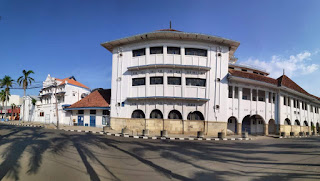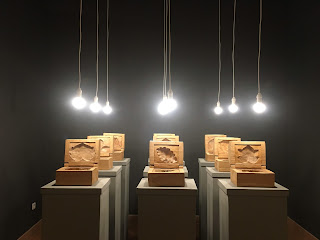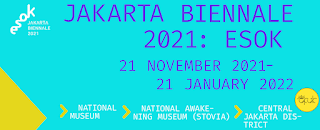Cirebon
Unexpected Cirebon
After the closing ceremony of Asian Games, me and my friend decided to take a short vacation before starting work at the new place. Due to limited time and impromptu plans, we decided to go to Cirebon. It merely took around 3 hours from Jakarta - Cirebon by train. Previously, I had no idea about the tourist attraction in Cirebon. But after visiting Cirebon, I fell in love with the palaces in the city known as the city of small prawns.
The Etymology of Cirebon
Since initially most of the community's work was as fishermen, other jobs developed, such as fishing small shrimp along the coast which could be used for making shrimp paste. Then there is also the manufacture of "petis" and salt.
The water used for making shrimp paste finally created the name "Cirebon" which came from Cai (water) and Rebon (rebon shrimp) which developed into the Cirebon nowadays.
Keraton Kasepuhan Cirebon
Cirebon is one of the regions in the archipelago that has a long history of Islamic culture. This can be seen from the building of the Kasepuhan Palace in Cirebon.
At the beginning of its construction, the Kasepuhan Palace was built by Prince Emas Zainul Arifin with the intention of expanding the Keraton Pakungwati building, the first palace that was founded in 1430 in Cirebon.
Museum Pusaka Keraton Kasepuhan Cirebon
The location of this museum is still one area with the Kasepuhan Palace in Cirebon. The heirloom museum collection is about 1,000 pieces.
Brass hairpin, one of the collections of the Keraton Kasepuhan Cirebon Heritage Museum. Some other collections that can be seen are the Singa Barong carriage used for the Sultan's carnival, Ani-ani / crabs, namely small knives for rice harvesting, cannons, various special weapons, various accessories such as bridal jewelry, as well as, various wood carvings, a set of Sekaten gamelan, and much more.
Some of Museum Collections
Keraton Kanoman
Keraton Kanoman was founded in 1510 Saka or 1588 AD by Sultan Kanoman I, who was the 7th descendant of Sunan Gunung Jati or Syarief Hidayatullah.
The Kanoman Sultanate was born from the desire of the Sultan of Banten Ki Ageng Tirtayasa who crowned two princes from Putra Panembahan Adining Kusuma (Mataram Kingdom) to rule in two sultanates.
Prince Kartawijaya ruled in the Kanoman Sultanate and was given the title Sultan Anom. Meanwhile, Pangeran Syamsuddin Martawijaya ruled in the Kasepuhan Sultanate with the title Sultan Sepuh.
In this palace, historic relics are stored, ranging from the palace's carriage, household appliances, to palace weapons. One of the royal carriages that are still stored here is the Naga Liman Paksi made of sapodilla wood and was made by Prince Losari in 1350 Saka or 1428 AD. The Naga Liman Paksi Train is a large carriage for Sunan Gunung Jati. The naming of the train is also related to its shape, which is a combination of a paksi (bird), a dragon, and a liman (elephant) holding a trident-shaped weapon. The combination of these forms also symbolizes the three forces, namely land, sea, and symbolizes territorial integrity.
Keraton Kacirebonan
Keraton Kacirebonan is the youngest of the four palaces in Cirebon. This palace was founded on the initiative of Prince Muhamad Haerudhin. He was the fourth Crown Prince of Sultan Kanoman who fought against the Dutch colonial rules.
Occupying a land area of 2.5 hectares, Keraton Kacirebonan has Paseban Kulon on the left and Paseban Wetan on the right side of the palace. Both function as a reception area and dance practice, namely the Cirebon mask dance.
Entering the main building, Keraton Kacirebonan has a green color that dominates the 8 pillars as the main pillars supporting this well-maintained building.
Keraton Kacirebon
Heirloom Sunshade of the Palace
Palace Kitchen
Keraton Kaprabonan
Kaprabonan belongs to the Kanoman Palace family which was founded in 1682 by Prince Adipati Kaprabon. The Prince was the eldest son of Sultan Kanoman I, who preferred his concern for the field of religion rather than for government. Until now, this place is inhabited by a family descended from the Adipati Kaprabonan which is located close to the Kanoman Palace.
Keraton Kaprabonan
Sunyaragi Cave Water Park
One by one, the dark and narrow caves have to be explored. The cavity that becomes the connecting medium between the caves must also be passed. With an area of about 15 hectares, Sunyaragi Cave Water Park has 13 caves connected by large cavities.
Etymologically, the name Sunyaragi comes from two words, namely silent and "raga". Meanwhile, literally, this name means a place to purify the body or meditate. The construction of the Sunyaragi Cave was initiated by Prince Emas Zaenul Arifin.
In this period, Sunyaragi Cave Water Park has two functions. Apart from being used as recreation for the royal family, this cave was also used as a place to build strength against the Dutch.
Goa Sunyaragi
Cirebon Traditional Mask
The interesting points about this visit, I could try one of the traditional masks in the palace. Besides that, I also played darts in Kuningan area where this sport is useful for increasing concentration and relieving stress.
"We exist because our ancestors exist, respect and take care for their heritage, exemplify its glorious history." The quote of Sultan Sepuh XIV.
Reference:
Personal photos and documentation
Personal impression and experience
https://cagarbudaya.kemdikbud.go.id/public/objek/detailcb/PO2014082800009/keraton-kasepuhan-cirebon
https://www.indonesiakaya.com/jelajah-indonesia/detail/keraton-kanoman
https://jabarprov.go.id/index.php/potensi_daerah/detail/78
https://www.indonesiakaya.com/jelajah-indonesia/detail/menenangkan-jiwa-di-taman-air-gua-sunyaragi






















Comments
Post a Comment